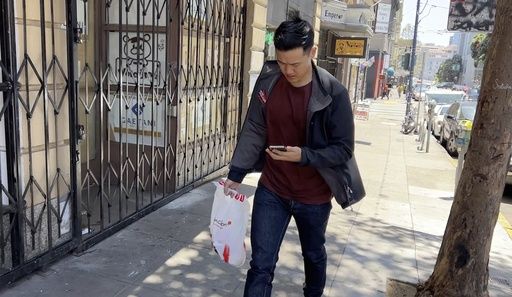Your DoorDash driver? He’s the company’s co-founder
Andy Fang, DoorDash’s co-founder and chief technology officer, picks up and delivers food orders to customers in downtown San Francisco on Saturday, June 15, 2023. Fang is one of a growing number of executives who work shifts on the front lines of the companies they run. All DoorDash salaried employees are required to make deliveries or work directly with customers or merchants several times a year. (AP Photo/Terry Chea)
SAN FRANCISCO (AP) — On a recent afternoon in San Francisco, a DoorDash driver was circling the neighborhood — first in his car, then on foot — trying to find the restaurant where he needed to pick up two orders. Finally, he Googled the location and realized DoorDash’s app sent him to the wrong address.
It’s an error he vowed to fix, and he probably will. Because that worker is Andy Fang, DoorDash’s chief technology officer and one of the company’s three co-founders.
“If it happens with one restaurant, it might actually be happening with a lot of other restaurants as well,” Fang said after he retrieved the orders and settled back into his car. “If we can see why that happened, maybe we can fix other issues too.”
Fang is one of a growing number of executives who occasionally do the hourly work that makes their companies hum. Starbucks’ new CEO, Laxman Narasimhan, is a trained barista and puts in a half-day of work at a store each month. Uber CEO Dara Khosrowshahi and Lyft CEO David Risher occasionally shuttle passengers. Air New Zealand CEO Greg Foran has been spotted serving drinks and snacks on flights.
Amazon recently re-launched a program called the Associate Experience Week, which encourages employees to shadow operations workers for a week to gain a better understanding of their job. The program is mandatory for some managers. A1 Garage Door Service, which operates in 16 states, also encourages job-shadowing and requires all employees to learn skills outside their immediate responsibilities. A1 CEO Tommy Mello says the policy promotes empathy and collaboration.
But few companies have a program as robust as WeDash, which requires thousands of salaried DoorDash employees in the U.S., Canada and Australia to complete at least four deliveries per year. Employees are strongly encouraged to make deliveries monthly. They can use work time to complete those shifts, and they keep any money they make.
“We just want to make sure that people who are working here, who are supporting our audiences, are understanding what people are going through,” Fang told The Associated Press.
When they started DoorDash a decade ago, while they were still students at Stanford, Fang and the company’s other two co-founders — CEO Tony Xu and Chief Product Officer Stanley Tang — made all the deliveries themselves.
“We had to. There was nobody else to do them,” Fang said. “But what we quickly found out was that by doing these deliveries ourselves, we learned a ton of insights into what it actually took to get these deliveries fulfilled.”
The company started WeDash in 2015 to make sure every employee was getting those insights. Fang said there are some exceptions; if an employee can’t drive, for example, they might visit merchants or work in the call center.
DoorDash has grown exponentially since then. In 2022, more than 6 million DoorDash drivers — all independent contractors — fulfilled 1.7 billion orders worldwide. DoorDash has expanded beyond restaurant delivery into convenience stores, groceries, pet stores and pharmacies.
Fang, who makes deliveries for at least an hour each month — sometimes with Xu and Tang in tow — says he has made real changes to DoorDash’s app based on his experiences. When he was on the East Coast recently, he set a time to make deliveries when he returned to California. But when he got home, he realized the time he had set was off by three hours because the app assumed he was still on the East Coast. He got that bug fixed.
Another new feature, introduced this week, arose from employee feedback in WeDash. The feature, Dash Along the Way, lets drivers specify where they want to start making deliveries and then assigns them orders that they can complete en route.
Fang also experiences drivers’ other frustrations. The wrong address in the DoorDash app cost him time delivering orders from Bonchon, a Korean fried chicken chain. On the afternoon he drove with an AP video journalist, Fang only made $15.50 for 51 minutes of work. That’s a little lower than the $17.97 that San Francisco DoorDash drivers typically make in an hour, according to Indeed.
It’s also vastly lower than what Fang pulls in as CEO. His annual compensation in 2022 totaled $2.79 million and Forbes pegged his net worth that same year at $1.1 billion, illustrating the widening salary gap between those at the top of a company and those at the bottom.
DoorDash and others recently pushed back against a new rule introduced in New York City implementing a minimum pay rate for app-based food delivery workers that could nearly triple their average earnings in the coming years. DoorDash said it may pursue legal action.
Fang said he knows there are limits to how much he can understand the day-to-day work of the company’s drivers, which is why he also seeks feedback from a council of drivers and from other employees.
Denise Rousseau, a professor of organizational behavior at Carnegie Mellon University, said there is a lot of value in asking workers to do other jobs within their company. Having senior leaders participate, as DoorDash does, sends an even stronger message.
“If you spend your own time on it, that’s not cheap talk anymore,” she said. “You are trying to convey, ‘This is the focus of our business and we care.’”
Elizabeth Bitter, who delivers for DoorDash in Broomfield, Colorado, didn’t know about the WeDash program but has noticed updates in the app that make their job easier.
DoorDash’s app used to ask if a delivery was good or bad, and if the driver felt safe or unsafe, after every delivery. Bitter appreciated the safety concerns, but filling out the survey slowed deliveries, so it was a relief when the app recently stopped requiring that information. Another recent update lets drivers unassign themselves from an order if they have to wait too long at a restaurant to get it.
“It does make me feel better knowing that the people I work for are getting to experience firsthand what it’s like to work for them,” said Bitter, who makes an average of $20 per hour on DoorDash.
___
Durbin reported from Detroit.
Copyright 2023 The Associated Press. All rights reserved.


